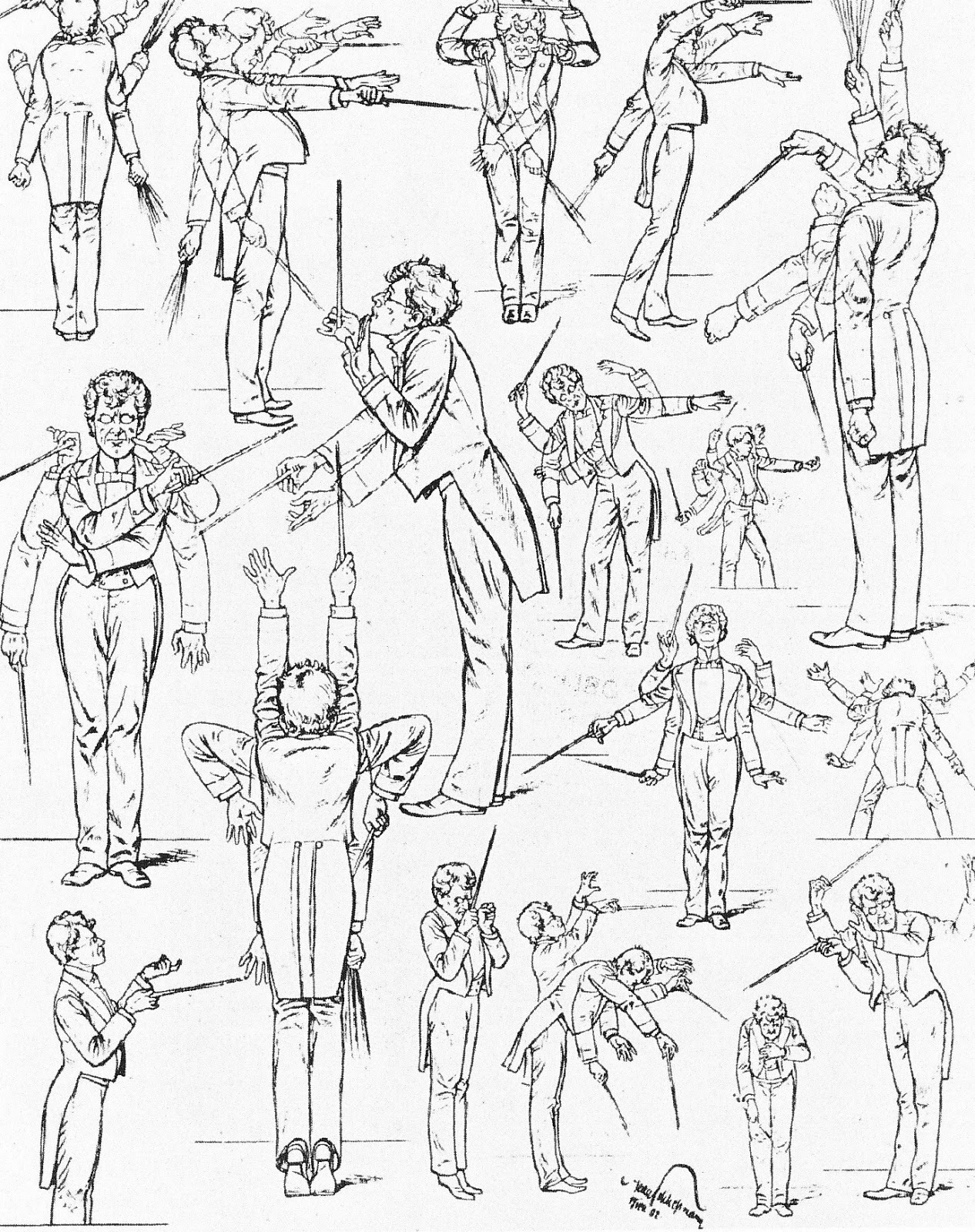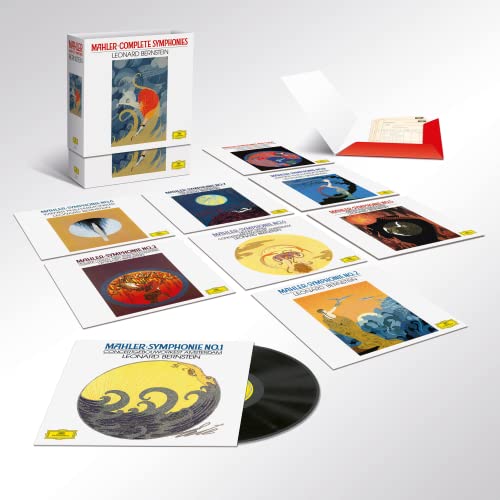Mahler–Complete Symphonies by Leonard Bernstein
DG resurrects the conductor that resurrected Mahler
The first time I ever saw a Gustav Mahler (1860-1911) symphony on my music stand, I was an 18-year-old student at the Eastern Music Festival in Greensboro, North Carolina. It was the Symphony No. 1 in D Major (sometimes subtitled “Titan”) and I was tasked with playing the delicate low English horn notes in the opening measures. From that point on Gustav Mahler’s orchestral works would hold a special place in my musical growth, heralding the finale concerts of various school years, summer festivals, and orchestral seasons. What makes these nine symphonic works so special are the enormous forces required to be brought together onstage, as well as the lengthy runtimes that often mean in concert they are programmed without any accompanying works.
For many listeners, Mahler represents the height of late 19th century romanticism in life as well as in music. Born in the Austrian Empire to Jewish parents, Mahler struggled as both a conductor and composer in artistically conservative and antisemitic Vienna. Nevertheless he made a significant impression and led a long conducting career in the city, leaving later in life for worldwide conducting posts, including a tenure with the New York Philharmonic. Still in many regards his life story represents that of a tortured artist, battling critics, personal health problems, the tragic death of his daughter, and a turbulent marriage.

A caricature of Gustav Mahler at the podium, dated 1901
In Mahler’s works one finds a reoccurring theme of fate, something he felt he was in a battle against. Mahler was terrified of the “curse of Beethoven”, a superstitious belief that after Beethoven, no composer could complete a tenth symphony. He even scrapped plans to make the work "Das Lied von der Erde" his 9th Symphony as he didn’t want it to be his last. In Mahler’s Symhony No. 6 in A minor, the composer specifies a number of catastrophic “hammer blows” of fate, with conductor Wilhelm Furtwängler calling it “the first nihilist work in the history of music.” Like other German romantics such as Beethoven, Weber, and Wagner, Mahler was also enamored with nature, and notably used works such as the Third Symphony and Das Lied von der Erde to express his awe of the natural world.

the "Mahler hammer" from a performance of Symphony No. 6
In total, upon his untimely death in 1911, Gustav Mahler left us with 9 complete symphonies, 6 orchestral song cycles, and the draft of an uncompleted 10th symphony. Throughout his career he conducted his own symphonies and during his lifetime, despite persistent derision from critics, his works enjoyed a reasonable amount of popularity. Following his death, Mahler's works fell into relative obscurity though some well-known devotees like Aaron Copland, Bruno Walter, and Willem Mengelberg were strong advocates. The popularity of Mahler’s music was further limited by its banning in Nazi Germany due to the composer’s Jewish background.
It wasn’t until the 1960s that Mahler’s music gained renewed popularity, and one big part of that revival was its championing by the New York Philharmonic's young celebrity conductor Leonard Bernstein. Not only did Bernstein perform and record all of Mahler’s symphonies for Columbia Records early into his tenure as music director, but he also introduced his works to an eager audience of children through his groundbreaking and televised “Young People’s Concerts”. Bernstein said of Mahler: “ I'm so sympathetic to Mahler: I understand his problem. It's like being two different men locked up in the same body; one man is a conductor and the other a composer ... It's like being a double man.”
By the 1980s Bernstein had become a household name in music and an international recording artist, now closely associated with Deutsche Grammophon. In 1985 he began what was to be his second recorded cycle of the symphonies of Mahler (third if you count his televised broadcasts with the Vienna Philharmonic in the 1970s). To accomplish this feat, Bernstein chose three orchestras that share a historic link to the composer: The Vienna Philharmonic, The Royal Concertgebouw Orchestra of Amsterdam, and the New York Philharmonic. These recordings were to be recorded from a combination of live concert performances, and captured using digital recording and mixing technology. Unfortunately Bernstein did not live to see this cycle completed. He passed away in 1990 before he could record the immense Symphony No. 8, or the unfinished sketches of Symphony No. 10.
These recordings (minus Nos. 8 and 10) were released individually by the label on CD and vinyl, and later as CD box sets in which was bundled earlier 70s radio broadcast recordings of the 8th and 10th symphonies. Until now, this complete cycle has never seen a combined vinyl release, let alone a complete remastering of the set specifically for the format.
Let’s get the difficult part out of the way, these are early digital recordings, captured at 44/16 bit resolution to 24 track digital tape. The engineer for this entire project was producer Hans Weber, who was responsible not just for the recording, but also the splicing together of different live takes to form a coherent musical performance on record. While the talent of each artist involved in producing these recordings is not in doubt, they are naturally limited by the early digital equipment.
Thankfully, for this release Deutsche Grammophon went to the experts at Emil Berliner studios, with engineers Rainer Maillard and Sidney Meyer performing not only a remastering, but in some cases a complete recording remix. As stated in the engineering notes included with this box set, for Symphonies 1-6 they had access to the original 24-track digital tapes, which allowed them to perform a complete digital remix. For Symphonies No. 7 and 9, the 24 track tapes could not be located, and they had to use the 2 track master, which limited their flexibility. The live broadcast recordings of Symphony No. 8 and the unfinished 10th were sourced from 2 track analogue tape masters.
The box set includes 16 LPs in individual jackets with the original gorgeous art deco cover art by Erté, as well as the original program notes. One notable absence is the lack of any lyric sheet for the symphonies that feature vocalists or choirs; a lazy omission. The records were pressed at Optimal and arrived flat and mostly free of visible defects, but unfortunately not as quiet as I’d like, with some loud ticks and pops that did not go away after ultrasonic cleaning. I was further disappointed by the thinness of the record jackets, which resulted in my box arriving with significant seam splits on every album.
From an artistic point of view, these are some of the best Mahler performances you can own, and certainly one of the best complete cycles ever released. Bernstein’s interpretations of Mahler’s scores are authoritative, and while most Mahler aficionados don’t consider him “the best”, he’s certainly a safe bet. Musically the only disappointment here is the live 8th Symphony, which is let down by some sloppy moments in the orchestra. The performances here of Symphonies No. 2, 3, 5, and 6 are some of the best I’ve heard, and the rest are certainly not slouches. Symphony No. 4 is very fine, but the conductor throws a curve ball in replacing the usual female soprano soloist in the final movement with a boy soprano. I enjoyed the novelty of the different sound, but others may not take so kindly to Bernstein’s artistic license.
Overall, Bernstein’s approach to Mahler is expressive but not indulgent. As anyone who has played a Mahler symphony can tell you, the composer is incredibly specific about what he wants in his scores, with numerous written German instructions on every line, and dynamics meant to weave between instruments. Bernstein follows these directions with intent, and because of that these performances have both intimacy and direction. This is especially apparent in the heart wrenching Adagietto of Symphony No. 5, of which Bernstein is the undisputed master.

There are of course, lots of great Mahler recordings out there, I’m particularly fond of Bruno Walter’s 2nd with New York, Barbirolli’s 5th with the New Philharmonia, Giulini’s 9th with Chicago, and Solti’s 8th with the same orchestra. Further, I think Bernstein’s earlier 7th with New York on Columbia ever so slightly edges out his remake in terms of intensity and raw power, but overall I think if you were to own one set of Mahler Symphonies from one conductor, this set is an easy recommendation.
The Sound is a More Complicated Matter
Mahler’s symphonies are notoriously difficult to produce on the vinyl medium. They are long (Symphony No. 3 clocks in at nearly 90 minutes!), and they are dynamic, with freight train-sized climaxes. When Analogue Productions released Zubin Mehta’s Decca recording of Mahler’s Third a few years ago, I was enamored right up until the Finale, which is hopelessly distorted in the inner grooves of the last LP (not an alignment issue). Further, the recordings under review here are hampered by their redbook CD-resolution bitrate and early digital technology.
While I do not own any of the (now quite expensive) original vinyl pressings, I do have the complete cycle on CD and I never found it to be a sonic marvel. I also have the earlier 2016 reissue of this Symphony No. 5 recording, released by DG and remastered in-house at Optimal. This new Emil Berliner remastering beats it handily, with a wider soundstage and more instrumental definition compared to the rather muddy sounding 2016 cut.
I mostly enjoyed my tour through the sonics of this box set, aside from Symphony No. 1 which sounded very dull and for some reason dynamically suppressed, and the obvious clunker of Symphony No. 8. Otherwise the sound was mostly the best I’ve ever heard from these recordings. Symphony No. 6 in particular struck me as powerful and presented with excellent dynamics and a decent orchestral soundstage. However, one constant irritant I encountered was a rather glassy string sound that lacked depth and transparency. One minute I would be listening to a full and three dimensional horn section, and the next minute when the violins took over the melody I was scratching my head trying to figure out how a section of two dozen players could sound so thin and brittle.
One big disappointment was Symphony No. 7, which is my personal favorite Mahler symphony (probably because it has one of the most enjoyable English horn parts I’ve ever encountered). The performance is exceptional, especially in the finale, but both the 1st and the 5th movements are marred with finales cut too close to the inner groove, making the dynamic climaxes distort a bit more than I find acceptable when played on a Feickert-aligned Hana Umami Red.
Listening to 16 LPs of music is a bit of a task in and of itself, but I did find some time to compare the sound on these recordings to some of my old standbys, notably Georg Solti’s Decca recordings with the London and Chicago Symphonies. While the performances in both sets are fine (I give a slight edge to Bernstein), on my Decca LP of Symphony No. 7 for instance, instrumental colors were much more vivid, string sound had much more resonance, and soundstage was far deeper.
One notable contrast was in the second movement “Nachtmusik”. In this movement, there is a moment where the timpani thunders out of nowhere to respond to an earlier musical line in the low strings. I recall distinctly nearly jumping out of my chair the first time I heard this passage in the orchestra. On the Solti recording (which was notably also free of inner groove issues), this Timpani interruption was just as thunderous as I recall, and the drumheads reverberated through the perceived hall filling up my listening space. On the DG recording, these notes sounded mellow, subdued, and one dimensional, almost as if the timpani was behind a door offstage. This highlights the problem with some of these heavily mic’d digital recordings, where whether or not a dynamic is explosive, or an instrumental feature emerges from the texture, can be dependent on a control board as opposed to the natural hall balance.
I shouldn’t be so hard on these releases as there are definitely some impressive moments, particularly in the brass-heavy climaxes (for example the first movement of the 9th Symphony) that sound very clear and detailed. But the fact is that I think this box set will disappoint audiophile fans of large orchestral recordings and what they can convey on a high-end system. Fans of Mahler and Leonard Bernstein however should be delighted, as this is a landmark set of recordings that should always be in print on every format. Emil Berliner did a mostly great job aside from some issues in the 1st and 7th symphonies. Unfortunately for the most part, these recordings were handicapped to begin with.
There are other options out there. Speakers Corner did excellent sounding reissues of Solti’s 2nd and 3rd on Decca, and Giulini’s 9th on DG, which combine excellent sonics and top class performances. Likewise, Analogue Productions has a currently in-print reissue of the gorgeous sounding Living Stereo recording of Symphony No. 4 by Fritz Reiner and the Chicago Symphony, which is maybe not a first class interpretation of the work, but still a competent performance.
I can recommend this box set for listeners who are already fans of these recordings, or for general music fans that want to own an excellent set of Mahler performances on vinyl. If you are deeply invested in sound quality you might want to consider other recordings first, but that doesn’t mean you should ignore this set, especially if DG make the remastering’s from this set available as individual LPs, which it absolutely should. These are not the most sonically impressive Mahler symphonies on vinyl, but this is an important and historic set of performances that shouldn’t be ignored.












































.png)








